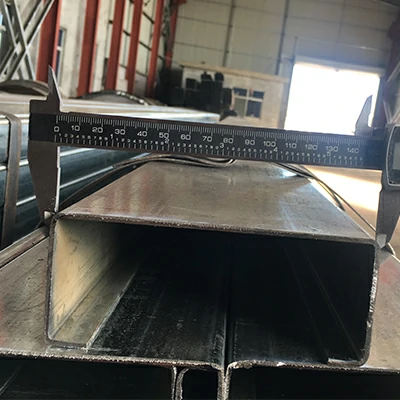After manufacturing, C-channel steel is typically packaged and transported using several methods to ensure safe handling and delivery to the intended destination:
- Packaging: C-channel steel is often bundled together for ease of handling and transportation. The bundles are usually secured with steel straps or wire ties to prevent movement during transit. Depending on the size and quantity of the steel channels, they may be bundled into stacks or placed onto pallets for added stability.
- Protection: To protect the C-channel steel from damage during transportation, it may be wrapped in protective materials such as plastic or paper. This helps prevent scratches, dents, and corrosion caused by exposure to moisture or other elements during transit.
- Labeling: Each bundle or pallet of C-channel steel is typically labeled with important information such as the material grade, dimensions, quantity, and destination. This ensures that the steel can be easily identified and sorted upon arrival at its final destination.
- Loading: Once packaged and labeled, the C-channel steel is loaded onto trucks, flatbed trailers, c channel steel suppliers or shipping containers for transportation. Specialized equipment such as forklifts or cranes may be used to load and unload the steel safely.
- Transportation: C-channel steel is transported via various modes of transportation depending on the distance and destination. It may be shipped by truck, rail, or ocean freight, depending on logistical considerations such as cost, transit time, and accessibility.
- Handling: During transportation, care is taken to handle the C-channel steel properly to prevent damage. This includes securing the bundles or pallets to prevent shifting, avoiding rough handling or impacts, and complying with relevant safety regulations.
- Unloading: Upon arrival at the destination, the C-channel steel is unloaded using appropriate equipment and procedures. It is then inspected for any signs of damage or defects before being stored or installed according to the project requirements.
Overall, careful packaging, labeling, and transportation procedures are essential to ensure that C-channel steel reaches its destination safely and in optimal condition for use in various construction and industrial applications.
How do manufacturers handle welding processes in the production of welded c channel steel?
In the production of welded C-channel steel, manufacturers typically follow a series of steps to handle the welding process efficiently and effectively:
- Material Preparation: The first step involves preparing the materials for welding. This includes cutting steel plates or coils to the required dimensions for forming the C-channel profiles. The edges of the steel strips or plates may be prepared by machining or bevelling to ensure proper fit-up during welding.
- Forming: Once the materials are prepared, they are fed into a roll forming machine or press brake to shape them into the desired C-channel profile. This process involves bending and forming the steel strips or plates into the appropriate shape using rollers or dies.
- Alignment and Fixturing: Before welding, the formed C-channel profiles are carefully aligned and fixtured to ensure proper alignment and fit-up of the joints. Fixturing devices such as clamps, jigs, or welding fixtures are used to hold the components in place during welding.
- Welding Process Selection: Manufacturers select the appropriate welding process based on factors such as material thickness, production volume, and weld quality requirements. Common welding processes used for C-channel steel production include:
- Arc Welding: This includes processes such as Shielded Metal Arc Welding (SMAW), Gas Metal Arc Welding (GMAW), and Flux-Cored Arc Welding (FCAW).
- Submerged Arc Welding (SAW): In this process, an arc is submerged beneath a flux layer, providing efficient heat transfer and high deposition rates.
- Gas Tungsten Arc Welding (GTAW): Also known as Tungsten Inert Gas (TIG) welding, this process is used for high-quality welds on thin materials.
- Gas Metal Arc Welding (GMAW): Also known as Metal Inert Gas (MIG) welding, this process is suitable for high-speed, semi-automatic welding.
- Welding: Once the welding process is selected, skilled welders or automated welding equipment are used to weld the joints of the C-channel profiles. Welding parameters such as voltage, c channel steel for sale current, travel speed, and electrode type are carefully controlled to achieve optimal weld quality and penetration.
- Post-Weld Treatment: After welding, the welded joints may undergo post-weld treatments such as grinding, smoothing, or surface cleaning to remove any weld spatter, slag, or surface imperfections. This helps improve the appearance and integrity of the welded joints.
- Inspection and Quality Assurance: Finally, the welded C-channel steel undergoes inspection and quality assurance processes to ensure that it meets specified standards and requirements. This may include visual inspection, dimensional checks, weld quality testing, and non-destructive testing methods such as ultrasonic testing or X-ray inspection.
By following these steps and adhering to strict quality control procedures, manufacturers can produce high-quality welded C-channel steel with consistent weld integrity and dimensional accuracy for various structural and construction applications.
